You are viewing ARCHIVED content published online before January 20, 2025. Please note that this content is NOT UPDATED, and links may not work. Additionally, any previously issued diversity, equity, inclusion or gender-related guidance on this webpage should be considered rescinded. For current information, visit https://www.blm.gov/blog.
The Line in the Sand
By Kate Miyamoto, Public Affairs Specialist, California Desert District
In the shifting world of the dunes, one thing remains – sand. It fills every exposed orifice, weaves into strands of hair, slips under fingernails. Sand is what brings thousands of visitors to two of the busiest recreation areas BLM manages in California - Imperial Sand Dunes and Dumont Dunes off-highway vehicle recreation areas - enticed by the recreation opportunities of the dunes.
In the desert, winter is the busiest time of year for off-highway vehicle recreation at Imperial Sand Dunes and Dumont Dunes especially on the holiday weekends of Halloween, Thanksgiving, New Year’s, Martin Luther King Jr. Day, and Presidents’ Day. I was lucky enough to visit both areas over Presidents’ Day weekend, the end of the busy season, where visitor numbers at Imperial Sand Dunes reach about 100,000 - 150,000 and about 8,000 - 45,000 at Dumont Dunes.
Dumont Dunes is in a remote area near the California-Nevada border and consists of about 8,000 acres of sand dunes nestled between wilderness and Areas of Critical Environmental Concern, with the historic Tonopah and Tidewater Railroad, which operated between 1905 – 1940, to the east. Imperial Sand Dunes is a six-hour drive south to the California-Mexico border and the largest mass of sand dunes in California, about 40 miles long by 5 miles wide, formed by the windblown sands of ancient Lake Cahuilla.
On the approach to Dumont Dunes, I watch three tiny black dots in the distance, like ants on an ant hill, climbing the bowls and edges of the sand dunes. It’s the Friday before Presidents’ Day weekend and visitors flow into the camping area pulling all-terrain vehicles, motorcycles, sand rails, utility terrain vehicles, and dune buggies. Off-highway vehicle enthusiasts flock to the area, enticed by the open expanse, challenging bowls, steep climbs, and flowing transitions. The incident command station is gearing up for a busy weekend, with law enforcement support from Mojave National Preserve and other BLM offices, and the Sheriff’s Department, communications specialists, and emergency services on site.
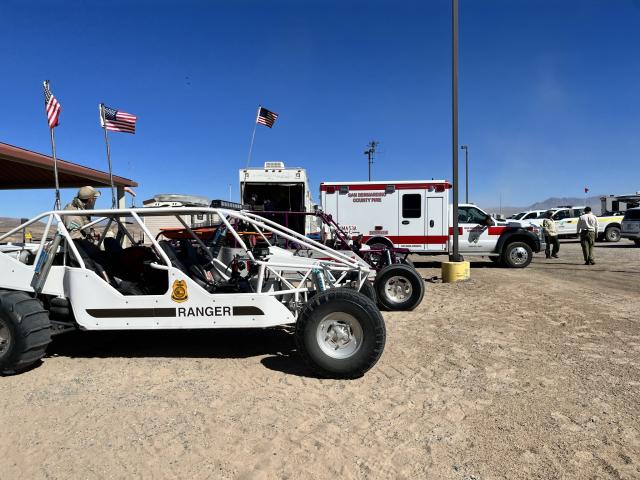
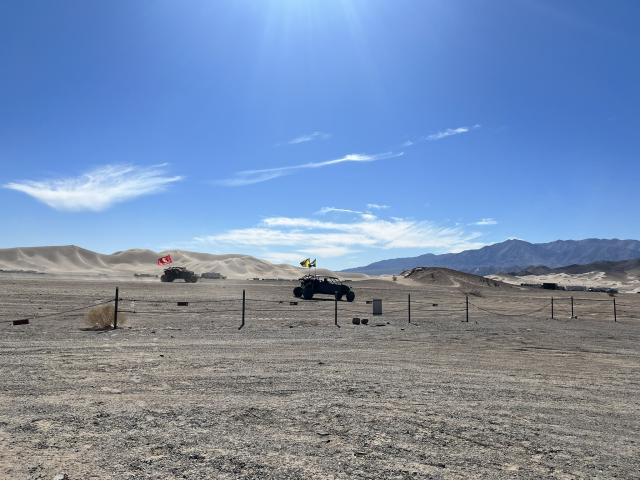
The appeal of the sand dunes is apparent. At Dumont Dunes, the steep and varying slopes make for an exhilarating ride, and the panoramic views of volcanic hills are breathtaking. At Imperial Sand Dunes, you’re beamed into to a sand planet with miles of dunes to explore, a place for solitude and adventure.
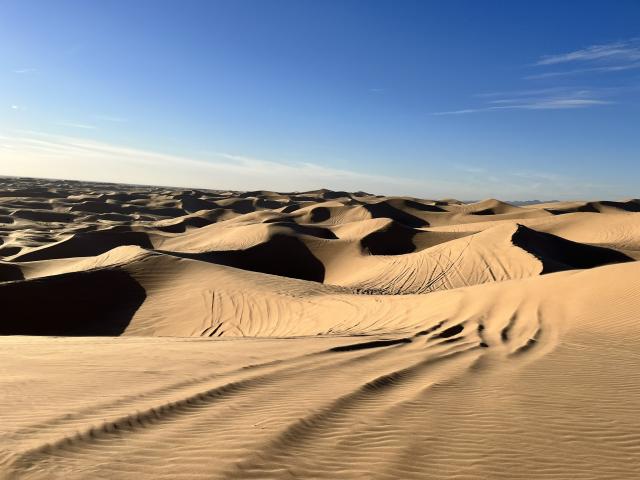
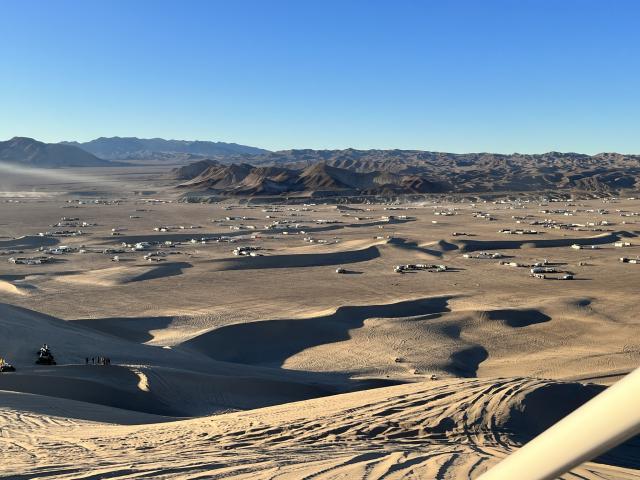
Dumont Dunes and Imperial Sand Dunes exemplify the BLM’s rustic recreation experience with few developed areas, where visitors choose where to ride and camp. Visitors must be good stewards, prepare, and follow the rules. There are no campsites to pay for or reserve and visitors ride at their own risk, no speed limits (except within 500 feet of highways/access roads, 50 feet from campsites), no trails to follow.
But there are rules to follow to maintain order and safety in the sand world. A pass is required for every vehicle and rig, the cost depending on the days and length of the trip. Camping is limited to a maximum of 14 consecutive days. Helmets, safety flags, lights, and vehicle registration are required. Trash must be cleaned up and packed out. Glass containers, target shooting, driving under the influence, and drugs are prohibited. While most visitors abide by the rules, law enforcement rangers are present to hold the line in the sand - they ensure compliance, maintain order and safety in the sand world.
I arrive at Imperial Sand Dunes on Sunday of the holiday weekend, the law enforcement ranger station bustling with activity. We pull up for a 9 a.m. briefing where the day shift of about 15 law enforcement rangers gather to check in, discuss watch outs, and recap events from the previous day.
It takes about 100 people - BLM law enforcement rangers, recreation staff, communications specialists, and managers - to support and run Imperial Sand Dunes on a busy holiday weekend. About 35 BLM law enforcement rangers came from across the country on national detail to help.
After the briefing, rangers head out on patrol. I’m fortunate to ride along with local El Centro Law Enforcement Ranger Brian Puckett. He tells me it’s common for BLM law enforcement rangers to respond to 60-70 medical calls and make several thousand contacts during a holiday weekend. During the patrol, I witness Brian deftly deal with ticket inquiries, medical issues, car searches, litter, and expired registrations. Brian is a rare gem; he is one of the only BLM law enforcement rangers who is also a paramedic and trains about 70-80 hours a year to maintain his license.
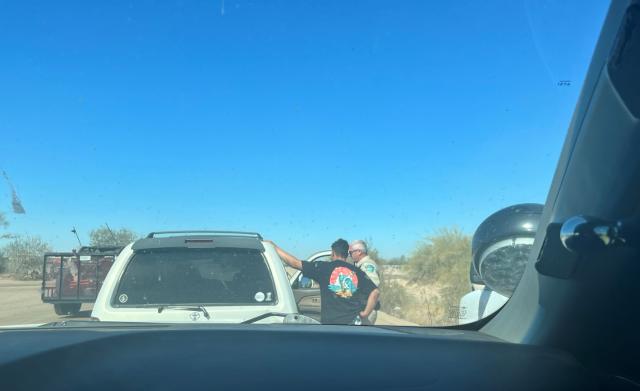
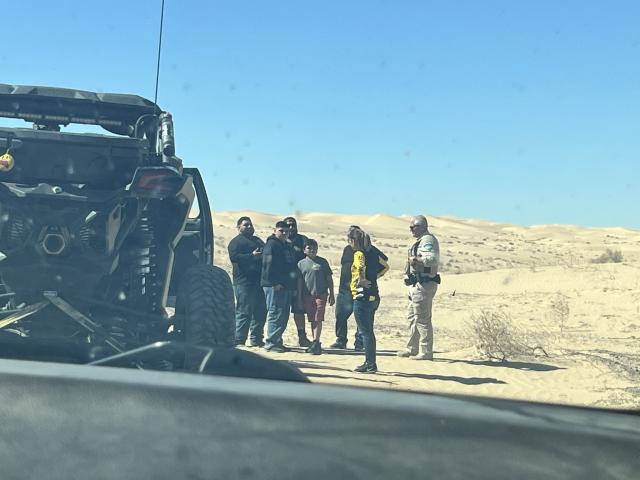
BLM law enforcement rangers are chameleons - authoritative but approachable, enforcers but listeners, stern but friendly. And always alert, professional, and understanding as they are under constant attention and scrutiny by the public. It’s as if every action is being watched, and it is: a simple stop to talk to a visitor was recorded with a smartphone. As a law enforcement ranger, Brian understands its part of the job, but that doesn’t make it easy. Sometimes you’re given obscene hand gestures, called names, or met with angry words. But for the few unpleasant encounters, Brian says 90% of his interactions are pleasant and the public is appreciative of BLM law enforcement presence. On the ride along, we are waved down, smiled at, thanked.
There is a lot resting on law enforcement ranger’s shoulders, and I’m not just talking about the 20-pound vests on their backs filled with an assortment of tools, radios, batteries, pens, phones, etc. First impressions weigh heavy, and rangers are often the public’s only face-to-face interaction with the BLM. I witness Brian hold the weight easily, handling situations with patience, composure, professionalism.
The key to a successful and safe weekend at two of the busiest off-highway vehicle recreation areas in the California Desert District is maintaining good communication. Law enforcement rangers, emergency services, BLM staff and managers need to maintain constant contact with dispatch centers, emergency responders, and each other.
Enter the compact rapid deployable, a mini deployable cell tower. The compact rapid deployable generates a two-mile radius area of FirstNet or Verizon cellular and Wi-Fi coverage anytime and anywhere. Compact rapid deployables link to FirstNet or Verizon via satellite and do not rely on commercial power making them ideal for use in rural and remote areas like the sand dunes. This new technology is available through DOI’s Joint Communication Infrastructure Improvement Program which started in 2017. BLM Nevada is running a one-year pilot program, using compact rapid deployables at several events around the state and in neighboring California.
Compact rapid deployables were present at Dumont Dunes and Imperial Sand Dunes over the holiday weekend. The unassuming three by five-foot white box on wheels, sits at the incident command post or ranger stations, complete with 15-foot-high antennae with a constant hum from its generator.
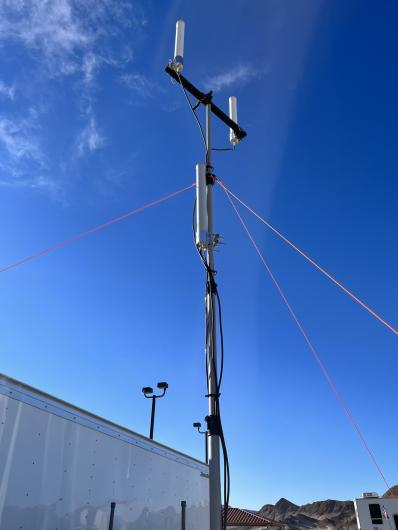
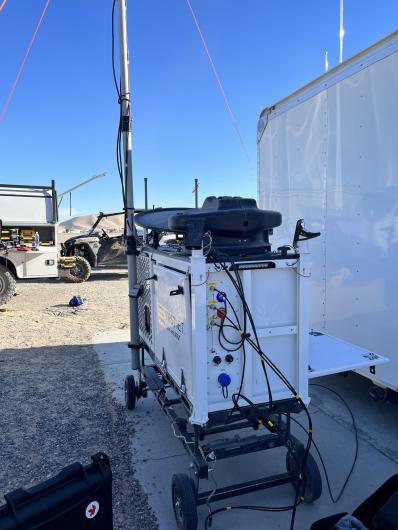
“We surveyed BLM staff, and everyone responded that the compact rapid deployable helps them do their jobs better,” said Dalton Black, Operations Support Branch Chief for BLM Nevada, who brought a compact rapid deployable to Dumont Dunes. “We’ve used compact rapid deployables at several BLM events including the King of the Hammers in California, Sand Mountain Recreation Area in Nevada and will use it at Burning Man in August.”
The compact rapid deployable is self-sufficient, with interior heating and cooling, internal and external lights, and a satellite. It can be deployed by a single person in 10 minutes. Without the compact rapid deployable, radios are the only way to communicate in these remote recreation areas.
“Having an added way of communicating to ensure officer safety is paramount for me,” said Chief Law Enforcement Ranger Robert Dockery, Barstow Field Office, the same office that manages Dumont Dunes.
Good communication is vital for maintaining public and law enforcement safety. I witnessed several medical incidents during the busy weekend, including a helicopter medevac, off-highway vehicle collisions and rollovers, and vehicle searches. Bad communication would make any of these incidents a challenge. There is constant checking in, verifying, calling for back up.
Without law enforcement rangers and the support of emergency services and recreation staff, the sand dunes would be worlds without order. But law enforcement rangers aren’t just rule enforcers. If you run into trouble or need help, law enforcement rangers are the ones who respond. They are a visible presence, a comfort (and warning) that someone is out there patrolling the sand. It’s taken time for BLM law enforcement to shift and build respect and reputation in the sand world. That often means rangers give warnings instead of tickets, stop more to have conversations, building trust with visibility and fairness. During my time as a guest in the sand world, I witnessed only appreciation for the dedicated work of law enforcement rangers.
In the shifting sand world, I’m glad one other thing remains besides the sand - the line in the sand, the BLM law enforcement rangers, patrolling the dunes, keeping visitors to the sand world safe.
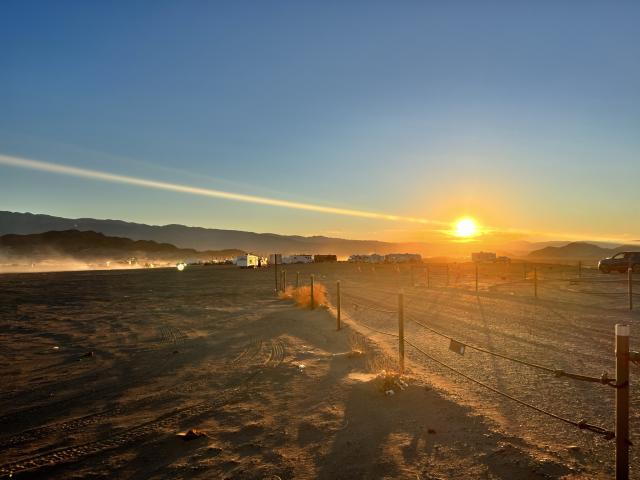
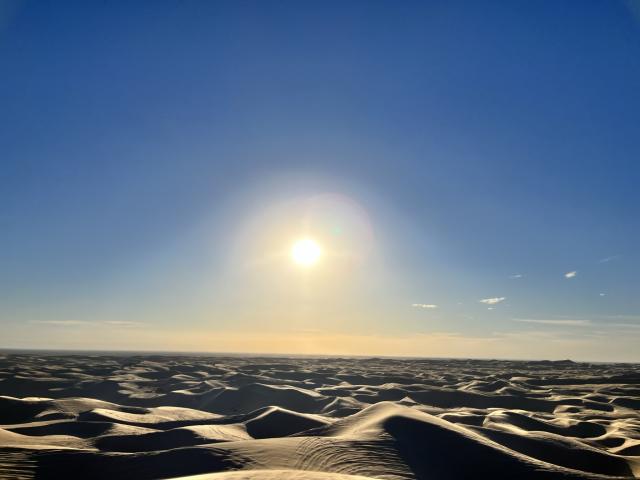
Related Stories
- Popular posts: BLM's most viewed blogs of 2025
- Take a First Day Hike on Your Public Lands
- Nine years of partnership pays off: Fitzhugh Creek Meadow restoration achieves dramatic results
- Stewardship and smiles at Samoa Dunes: BLM California hosts National Public Lands Day event
- Lake Havasu Fisheries Improvement Program is the gift that keeps giving
